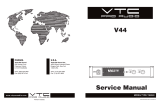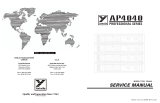Page is loading ...

Mega(Hi)Watt
One PCB, two classic
Hiwatt-based tones
Contents of this document are ©2021 Pedal Parts Ltd.
No reproduction permitted without the express written
permission of Pedal Parts Ltd. All rights reserved.

Important notes
If you’re using any of our footswitch daughterboards,
DOWNLOAD THE DAUGHTERBOARD DOCUMENT
•Download and read the appropriate build document for the daughterboard
as well as this one BEFORE you start.
•DO NOT solder the supplied Current Limiting Resistor (CLR) to the main
circuit board even if there is a place for it. This should be soldered to the
footswitch daughterboard.
POWER SUPPLY
Unless otherwise stated in this document this circuit is designed to be
powered with 9V DC.
COMPONENT SPECS
Unless otherwise stated in this document:
•Resistors should be 0.25W. You can use those with higher ratings but
check the physical size of them.
•Electrolytics caps should be at least 25V for 9V circuits, 35V for 18V
circuits. Again, check physical size if using higher ratings.
LAYOUT CONVENTIONS
Unless otherwise stated in this document, the following are used:
•Electrolytic capacitors:
Long leg (anode) to square pad.
•Diodes/LEDs:
Striped leg (cathode) to square pad. Short leg to square pad for LEDs.
•ICs:
Square pad indicates pin 1.

R1 10M
R2 1K
R3 3K3
R4 3K3
R5 12K
R6 200K
R7 10M
R8 3K3
R9 3K3
R10 empty
R11 100K
R12 10K
R14 empty
R15 130R
R16 3K3
R17 3K3
R18 10M
R19 12K
R20 12K
R21 62K
R22 100K
C1 250p
C2 100n
C3 220n
C4 empty
C5 470n
C6 47n
C7 jumper wire
C8 10n
C9 4n7
C10 470p
C11 jumper wire
C12 100n
C13 empty
C14 2n2
C15 2n2
C16 10n
C17 100u elec
C18 100u elec
C19 4u7 elec
C20 100u elec
C21 10u elec
C22 100u elec
C23 10u elec
D1-3 9.1V Zener
Q1-3 BS170
GAIN 500KA
MASTER 100KA
TREBLE 500KB
BASS 500KA
MIDS empty
Schematic + BOM - NORTH

Schematic
NORTH

R1 1M
R2 1K
R3 3K3
R4 3K3
R5 22K
R6 220K
R7 1M
R8 3K3
R9 3K3
R10 100K
R11 100K
R12 22K
R14 220K
R15 130R
R16 3K3
R17 3K3
R18 1M
R19 10K
R20 10K
R21 62K
R22 100K
C1 empty
C2 3n3
C3 100n
C4 47p
C5 680n
C6 47n
C7 1n
C8 47n
C9 47n
C10 220p
C11 1n
C12 100n
C13 220n
C14 2n2
C15 2n2
C16 empty
C17 22u elec
C18 10u elec
C19 empty
C20 22u elec
C21 empty
C22 47u elec
C23 10u elec
D1-3 9.1V Zener
Q1-3 BS170
GAIN 500KB
MASTER 250KA
TREBLE 250KB
BASS 500KA
MIDS 100KB
Schematic + BOM - SOUTH

Schematic
SOUTH

The power and signal pads on the PCB conform
to the FuzzDog Direct Connection format, so
can be paired with the appropriate
daughterboard for quick and easy offboard
wiring. Check the separate daughterboard
document for details.
Be very careful when soldering the transistors
and diodes. They’re very sensitive to heat. Keep
exposure to heat to a minimum (under 2
seconds) and leave a few seconds between
soldering each leg. The BS170 are also very
sensitive to static.
Snap the small metal tag off the pots so they
can be mounted flush in the box.
You should solder all other board-mounted
components before you solder the pots. Once
they’re in place you’ll have no access to much of
the board. Make sure your pots all line up nicely.
The best way to do that is to solder a single pin
of each pot in place then melt and adjust if
necessary before soldering in the other two
pins. Same for the toggle switch. If your pots
don’t have protective plastic jackets ensure you
leave a decent gap between the pot body and
the PCB otherwise you risk shorting out the
circuit.
PCB layout ©2021 Pedal Parts Ltd.

Test the board!
Check the relevant daughterboard document for more
info before you undertake this stage.
UNDER NO CIRCUMSTANCES will troubleshooting help
be offered if you have skipped this stage. No exceptions.
Once you’ve finished the circuit it makes sense to test is before starting on the switch and LED
wiring. It’ll cut down troubleshooting time in the long run. If the circuit works at this stage, but it
doesn’t once you wire up the switch - guess what? You’ve probably made a mistake with the switch.
Solder some nice, long lengths of wire to the board connections for 9V, GND, IN and OUT. Connect
IN and OUT to the jacks as shown. Connect all the GNDs together (twist them up and add a small
amount of solder to tack it). Connect the battery + lead to the 9V wire, same method. Plug in. Go!
If you’re using a ribbon cable you can tack the wires to the ends of that. It’s a lot easier to take them
off there than it is do desolder wires from the PCB pads.
If it works, carry on and do your switch wiring. If not... aw man. At least you know the problem is
with the circuit. Find out why, get it working, THEN worry about the switch etc.
Your completed circuit board
including pots

Wiring shown above will disconnect the battery when you remove the jack plug
from the input, and also when a DC plug is inserted.
The Board GND connections don’t all have to directly attach to the board. You
can run a couple of wires from the DC connector, one to the board, another to
the IN jack, then daisy chain that over to the OUT jack.
It doesn’t matter how they all connect, as long as they do.
This circuit is standard, Negative GND. Your power supply should be Tip
Negative / Sleeve Positive. That’s the same as your standard pedals (Boss etc),
and you can safely daisy-chain your supply to this pedal.
L
E
D
BOARD
OUT
BOARD
9V
BOARD
GND
BOARD
GND
BOARD
GND
BOARD
INPUT
BATTERY
+
IN
OUT
L
E
D
BOARD
GND
BOARD
9V
+
Wire it up (if using a daughterboard please refer to the relevant document)

This template is a rough guide only. You should ensure correct marking of your
enclosure before drilling. You use this template at your own risk.
Pedal Parts Ltd can accept no responsibility for incorrect drilling of enclosures.
FuzzDog.co.uk
Drilling template
Hammond 1590B
60 x 111 x 31mm
It’s a good idea to drill the pot and
toggle switch holes 1mm bigger if
you’re board-mounting them.
Wiggle room = good!
Recommended drill sizes:
Pots 7mm
Jacks 10mm
Footswitch 12mm
DC Socket 12mm
Toggle switches 6mm
35mm
27mm
/














